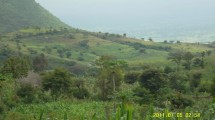Abstract
This paper assesses the potential impact of planting of eucalypt trees as a strategy to reduce poverty in a less-favoured area of the highlands of Ethiopia. Results from simulations with a bio-economic model for a less-favoured case study area in the highlands are combined with survey data at community, household and plot level to assess how general the results of the bio-economic model are. Application of the bio-economic model shows clearly that land degradation, population growth, stagnant technology and drought threaten food security. Household welfare and land quality are deteriorating rapidly in the area and interventions are urgently needed to avoid human disaster. Planting of eucalypts on land unsuitable for crop production may substantially increase household incomes if market outlets for trees can be found. Tree planting will not have severe negative effects on food production or land conservation. A policy combining promotion of tree planting and conservation of cropland may achieve win-win benefits in terms of increased household incomes as well as more sustainable land-use. Analysis of survey data from the Amhara Region of Ethiopia reveals that there is a large area of land that is unsuitable for crop production located close to all-weather roads in the less-favoured areas of the region. Few trees have been planted on this type of land up to now. The past policy seems to have discouraged tree planting except on homestead plots that are more suitable for food crops.
Similar content being viewed by others
References
EFAP (Ethiopian Forestry Action Programme) (1993),The Challenge For Development, V. II, Ministry of Natural Resource Development and Environmental Protection, Transitional Government of Ethiopia, Addis Ababa.
Holden, S.T. and Shiferaw, B. (2000), ‘Development paths and policies for sustainable land management in Andit Tid, North Shewa: an exploration of policy alternatives’, Paper presented at the national workshop on ‘Policies for Sustainable Land Management in Addis Ababa’, May 22–23, 2000.
Holden, S.T. and Shiferaw, B. (in press), ‘Land degradation, drought and food security in a less-favoured area in the Ethiopian highlands: a bio-economic model with market imperfections’,Agricultural Economics (forthcoming).
Holden, S.T., Shiferaw, B. and Pender, J. (2001), ‘Market imperfections and land productivity in the Ethiopian highlands’,Journal of Agricultural Economics, 52(3): 53–70.
Jagger, P. and Pender, J. (2000), ‘The role of trees for sustainable management of less-favoured the case of eucalyptus in Ethiopia’, ETPD Discussion Paper No. 65, International Food Policy Research Institute, Washington, D.C.
Mekonnen, A. (1998), ‘Rural energy and afforestation: case studies from Ethiopia’, PhD-dissertation, Ekonomiske Studier No. 81, Department of Economics, School of Economics and Commercial Law, Göteborg University, Göteborg, Sweden.
Pender, J. and Hazell, P. eds. (2000),Promoting Sustainable Development In Less-Favoured Areas, 2020 Vision, Focus 4, IFPRI, Washington, D.C.
TGE (Transitional Government of Ethiopia) (1994),National Conservation Strategy, Vol. I and II, NCS Secretariat, Ministry of Natural Resource Development and Environmental Protection, Addis Ababa.
Yohannes, G. (1989), ‘Land-use, agricultural production and soil conservation methods in the Andit Tid area, Shewa Region’, Research Report No. 17, Soil Conservation Research Project, Ministry of Agriculture Soil and Water Conservation Development, Addis Ababa.
Author information
Authors and Affiliations
Additional information
This paper reports part of the IFPRI/ILRI project ‘Policies for Sustainable Land Management in the East African Highlands’. These two agencies have provided funds and logistical support for the work. The Norwegian Ministry of Foreign Affairs has provided funds for this research in the Amhara Region in Ethiopia. The authors also draw on earlier work funded by Research Council of Norway. Any correspondence should be directed to the first author.
Rights and permissions
About this article
Cite this article
Holden, S., Benin, S., Shiferaw, B. et al. Tree planting for poverty reduction in less-favoured areas of the Ethiopian highlands. Small-scale Forestry 2, 63–80 (2003). https://doi.org/10.1007/s11842-003-006-6
Issue Date:
DOI: https://doi.org/10.1007/s11842-003-006-6




